Hero AG: Inter Company Supply Chain Hub
Hero is an international group of enterprises for branded food products. To date most of the products have been produced by the regional companies only for their respective markets. However, recently new methods have been proposed in order to produce and market new products, like the lifestyle product Fruit2Day. Fruit2Day is a fresh food innovation and is produced only at one location. It is delivered to the regional organizations by means of a firmly knit supply chain. In order to provide maximum support and to have optimal control of this process at all times, Ramco Systems developed and put into service for Hero the Inter Company Supply Chain Hub.
table des matières
1. The Company2. Project Impetus
3. Inter Company Supply Chain Hub
Business Concept, Logistics, Process, Supply Chain Management, Application View, Data Exchange, Technological View, Security
4. Project Management and Operation
Development, Choice of Partner
5. Experiences
Investitions
6. Success Factors
1. The Company
Hero is a market leader in jellies and preserves in Europe and holds strong positions in baby food products, granola bars and baking decorations.
Background, Industrial Sector, Product and Target Group
Hero is a well established enterprise that has been domiciled in Lenzburg, Switzerland since 1886. As a holding company, the firm holds a majority shareholding in more than 20 regional companies. These companies exhibit a decentralized organization and operate largely independently. Products are produced for the respective national market according to country-specific recipes and raw materials (e.g., Schwartau marmalade with strawberries from Schleswig-Holstein). The reason for the different recipes lies also in the different preference in taste in the countries. For example, an Italian marmalade is usually too sweet for most Germans.
In addition to the financial tasks of the holding company, Hero is also actively seeking potential synergies between the interconnected companies with respect to products, their manufacture and packaging.
Today Hero holds the position of a producer of branded food products with a concentration in the areas of fruit processing (38 % of the sales in 2004), baby foods (17 %), grain products (8 %) and baking decorations (23 %). In 2005 the group achieved a turnover of approximately CHF 1.4 billion with more than 4'000 employees.
Fruit2Day is the first international product that was introduced and put on the market by the central office of the Hero group. The central office planned all aspects of the Fruit2Day projects, and the Hero holding company provided the investments. The recipes of the four different flavors for Fruit2Day are the same for all countries. Fruit2Day is a lifestyle product. Target groups are primarily women between the ages of 30 and 45, working women and mothers. The latter group is targeted because they are the decision-makers when it comes to buying food and what their families will consume.
Corporate Mission
We are an international food group with a focus on the production of branded food products for the retail trade. High quality products and qualified staff ensure our distinguished market position and continuous growth in our core areas. Our financial stability makes us a reliable partner for employees, customers and investors.
2. Project Impetus
Initial Scenario and Impulse for the Project
Fruit2Day is a beverage made of a mixture of fruit juices, morsels of fruit and fruit puree. It has no preservatives and, therefore, needs a continuous refrigeration chain. It has a shelf life of only 47 days, and of this period 26 days must be allocated to the retail trade. The relatively short shelf life was the decisive factor for the organization of the supply chain between production and delivery to the trade: all processes relating to the production, warehousing and delivery have to be checked on a routine basis and must run within the planned cycle.
Introduction of the Business Partners
Regional Hero Companies
Fruit2Day was developed by Hero Netherlands and launched on the Dutch market two years prior to the international distribution. Currently Fruit2Day is sold by regional Hero companies on the markets in the Netherlands, in Germany, Great Britain and in Switzerland. Owing to past experience and the decentralized organization of the individual regional companies, ERP systems of a plethora of manufacturers are used to control the business processes. For example, the Schwartau plants in Germany use SAP R/3; in contrast, Hero Netherlands uses a system developed by Baan.
Distributors
For each country in which Fruit2Day is sold, a single distributor was chosen for the entire marketing organization. This distributor manages the Fruit2Day inventory and also handles on a country basis the commissioning and distribution to the retail trade. For example, the firm Galliker was chosen for Switzerland. Galliker is simultaneously the distributor of Coop. Coop, the 2nd largest distributor of Switzerland, receives the commissioned Fruit2Day package, delivered directly by Galliker to the branch stores.
Institute for Business Engineering (IBE) of the University of Applied Sciences of Northwestern Switzerland (FHNW)
The Institute for Business Engineering (IBE) of the University of Applied Sciences of Northwestern Switzerland (FHNW) is engaged in the areas of supply chain management, logistics systems, management of cooperative networks and business process modeling. The Institute works under service contracts with its clients to model the organizational and technological processes.
Ramco Systems
Founded in 1989, Ramco Systems is currently the worldwide leading Indian provider of standard application software and E-business software solutions that integrate the processes inside enterprises and beyond the corporate boundaries. With more than fourteen branch offices in seven counties, Ramco Systems offers business solutions and cost-effective offshore application development to more than 1000 customers in more than twenty countries.
3. Inter Company Supply Chain Hub
The international processes for the sales, production and inventory planning of Fruit2Day are supported in essence by the “Inter Company Supply Chain Hub” application that was developed for Hero. The solution that was implemented and developed on the basis of Ramcos Busines Process Platform Virtual Works shall be described below from the business view, process view, application view and technological view.
Business View and Objectives
The event that triggered the project was the search for an implementable concept that makes possible an international supply chain for a refrigerated fresh food product and at the same time ensures a guaranteed supply and efficiency. The concept was developed in collaboration with students of the FHNW under the direction of Prof. Werner LĂĽthy.
[Logistics]The concept envisages loading the freshly prepared Fruit2Day batches from the production lines directly into trucks and transporting these batches directly to the distribution centers of the distributors in the marketing organization. From the inventory of these distribution centers the retailer in the respective country can receive a shipment within 24 hours. The production location itself does not have any warehousing facilities for the finished products. Therefore, the supply chain to be managed has only one warehousing point between production and delivery to the retail trade.
In this scenario the regional Hero companies and the Fruit2Day production do the planning and monitoring of the supply chain by means of regular web conferences and data exchange.
The business scenario in Figure 1.1 shows the participating organizations with the involved business units and the most important processes.
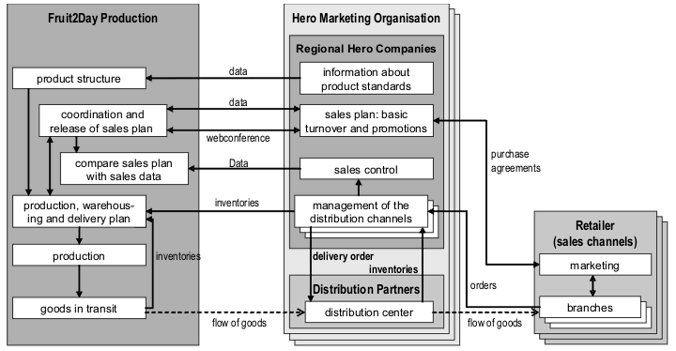
Figure 1.1: Production and Marketing Processes for Fruit2Day
Process View
The Inter Company Supply Chain Hub [Supply Chain Management] receives on a daily basis the sales plans, inventory figures and sales figures from the interlinked ERP systems of the regional companies. The weekly plans for sales and promotions are updated every week, and the monthly plans are updated once a month by the sales managers of the regional companies. The planning information that is received is consolidated once a week into a single sales plan by means of the Inter Company Supply Chain Hub.
At this stage the supply chain planner uses the consolidated plan to check whether there was a production bottleneck or a delivery shortage in a period of 13 weeks. If such a bottleneck or shortage occurred, the planner has two options:
He has the option of postponing, with the consent of the sales managers, any promotions that regional companies may have planned for the same period or, secondly, the planner may vary the inventories if the quantities permit it. He may increase, for example, one week earlier the inventories in the distributors' warehouses in order to then decrease the inventories to a defined minimum during the promotion.
In addition, the planner has the option of adjusting the production capacities in order to open up the bottlenecks. That is, within the scope of the solution he may change the shift model, the calendar, etc. for production.
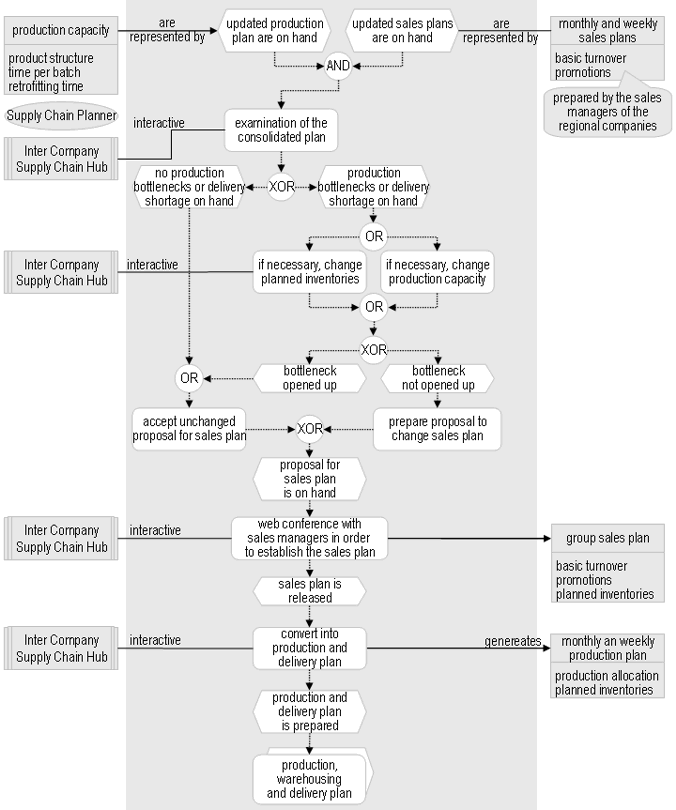
Figure 1.2 Process Coordination and Release of Sales Plan
The inventory range may never fall below one week and never increase above three weeks. Within this bandwidth lies the optimal position between readiness to deliver and costs. These key figures are determined for each regional company and each product variant and are included in the calculation of the new closing inventories. The corresponding targeted figures may be specified in the system for each product variant.
The system assists the supply chain planner, provided all information about the product structure and the time required to produce a batch are filed in the system and are included automatically in the calculation of the production allocation. With four Fruit2Day varieties, various packaging sizes (individual bottle, duopack or six pack) and with the country-specific labeling, there are currently approximately 80 product variants.
If the bottleneck cannot be opened up by changing the inventory range, postponing promotions or increasing the capacity, the supply chain planner may negotiate with the sales managers a new sales plan at a web conference. Hence, the moderation and the decision are the sole responsibility of the supply chain planner. In the final end he determines which regional organization shall receive which quantity. In this way the sales plan, which is consolidated with the cooperation of the sales managers, becomes the plan for the regional companies.
The supply chain planner uses the released sales plans in order to prepare the exact daily plans for production and delivery with the local PPC system. The objective of the daily plan is to achieve the closing inventories calculated for the next week. The daily plan is prepared every Thursday and Friday for the next week.
Application View
The import and export [Data Exchange] of inventory, sales and planning data between the Inter Company Supply Chain Hub, the ERP systems of the regional Hero companies and the PPC system at the production site is carried out via a file transfer protocol (FTP). The data are transmitted in the form of structured text files.
In order to calculate the production plan, the application uses the information about the structure of the products, the production capacity and the desired inventory range.
The product structure of Fruit2Day is described in the system by means of a hierarchical structure comprising four steps. On the top level there is the product program. On the second level the basic product: the four flavors of Fruit2Day. To this end, such data are filed as: for which flavor is a production line allocated for the production of a batch for what period of time, how large is a batch, etc. The third level acquires information about the labeling for a basic product (the labeling must be different for each regional company). On the fourth level information is filed about the units in which the product may be packaged (individual bottle, duopack, six pack).
Rules are also filed in the system: for example, the desired key figures of the situation (inventory buffer, minimum and maximum inventory in days), the maximum allowable storage duration of a specific product or the retrofitting and cleaning time of a production line that occurs in every product sequence.
The hierarchies and rules that are implemented in the Inter Company Supply Chain Hub were developed intentionally in a generic way in order to be able to use them for the production planning of other products.
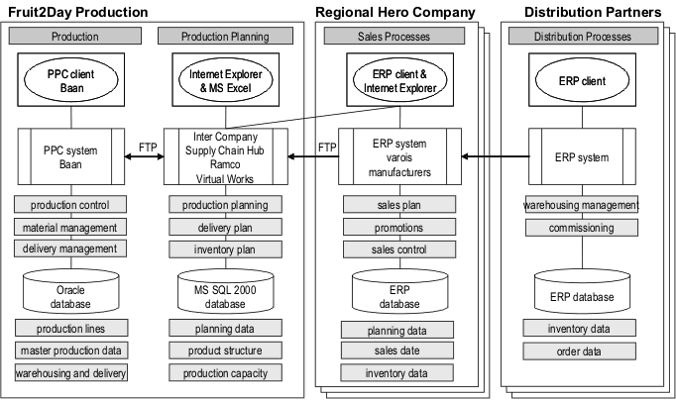
Figure 1.3: Application Overview and Integration Scheme
Technological View
The servers for the Inter Company Supply Chain Hub are provided at the production site. The regional Hero companies have access to the servers via the Internet. The sales plans and the inventory data are transmitted in an analogous manner via the Internet.
Since the servers have to be accessed from the Internet and the intranet, they are connected in the demilitarized zone (DMZ). The DMZ is a network zone in which systems may be addressed for specific connections from the Internet through the firewall. In this case the DMZ is released for web access and data transfer via FTP. Any attempt to access the intranet from the Internet is blocked by the firewall.
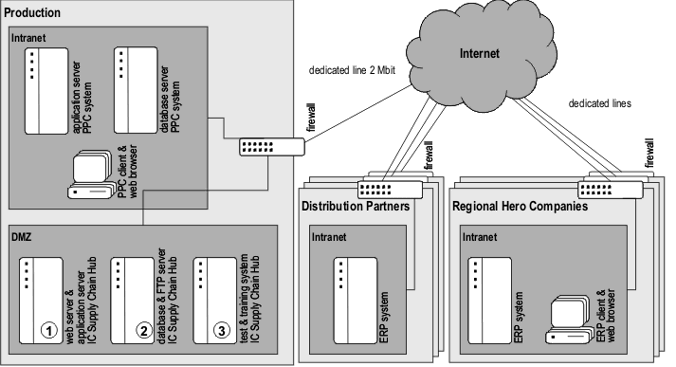
Figure 1.4: Application Overview and Integration Scheme
Table: 1.2: Inter Company Supply Chain Server Hardware and Software
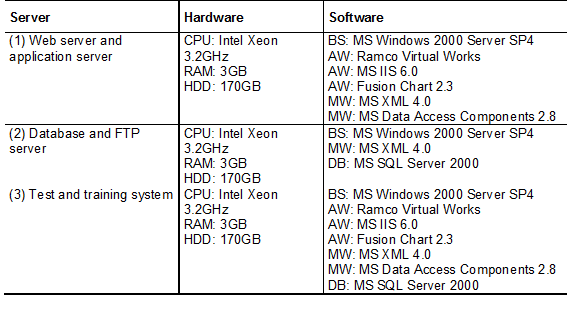
CPU: processor; RAM: working space of memory; HD: hard disk storage; BS: operating system; AW: application software; MW: middleware; DB: database software
For reasons relating to network security [Security] and the application, the servers that are used for the Inter Company Supply Chain Hub are provided exclusively for this application. Currently the servers are used by approximately ten persons; in the final state it will be approximately 40 persons.
In the future, when the hub will be used by additional production lines of the Hero group, the plan is to move the application together with the servers from the Netherlands to Switzerland.
The test and training system servers to test the software changes and is used to train the sales managers. Prior to the test runs and the training sessions, the updated information from the database of the productive system is copied into the database of the test and training system.
4. Project Management and Operation
Project Management and Change Management
The software was [Development] developed according to the structured methods of Ramco Systems. The procedure is specified by Ramcos Business Process Platform Virtual Works, which is divided into six specification levels (cf. Figure 1.5).
The business process level determines the processes that are to be satisfied with the solution. They are broken down into a sequence of functions and events. A function corresponds to the sphere of responsibility of the ultimate task bearer inside the process. In the model and process-oriented approach of Ramcos Business Process Platform Virtual Works, a function is also equivalent to a software component. Hence, prefabricated modules of tested process chains can be easily recombined and reconfigured or also supplemented by means of new components.
Components can be adapted to a large extent to the specific requirements of the enterprise. To this end, the components are divided into a sequence of activities. Activities consist of one or more consecutive masks, whose processing sequence is specified by the user interface flow. Therefore, the interactive elements of these masks represent the named tasks. The prerequisites and effects of the tasks are established by the business rules. On the top five specification levels the inputs to the processes, functions, activities, etc. are filed in a repository as a function of the specified model.
In the present case the process models are created up to the activity flow with special Microsoft Visio templates and then subsequently imported into Ramcos Business Process Platform Virtual Works. While importing, the flow charts regarding the systematic arrangements were validated. Then the other levels, according to Figure 1.5, were formulated with Ramco Business Process Platform Virtual Works. Only in the case of the business rules are the specifications in text, since experience has shown that there are always requirements that do not fit the schematic approach and, therefore, ought to be described in a natural language.
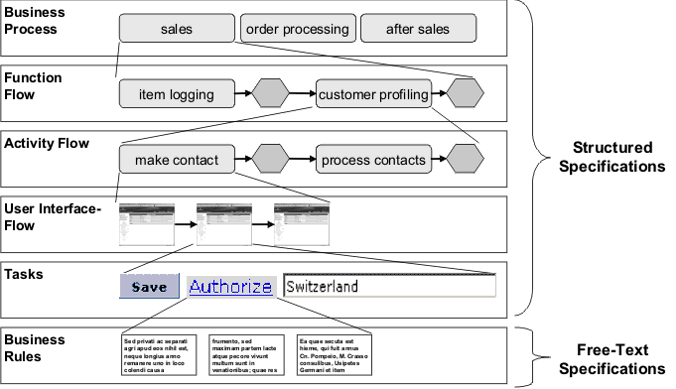
Figure 1.5: Specification Levels in Ramco Business Process Platform Virtual Works
This method makes it possible to derive at any time from the repository a prototype that already exhibits the total look & feel of the next phase of the system—including the option of navigating menus and masks. Thus, the specification may be evaluated in great detail by the subsequent users of the system. Requests for changes can be accepted, even before a single line of code is programmed. Just the access to data and the functionality of tasks are not yet in the prototypes. As the blue print, the said specifications form the basis for generating and testing the executable program code, which is written in the software factory of Ramco Systems in Chennai, India. The bulk of the code is automatically generated from the data of the repository. Only for those parts that are specified in a natural language is it necessary to do manual programming work. This “industrialized” software generation leads to low costs in the development and subsequent adaptations. At the same time it guarantees high reliability and high quality and significantly speeds up the process.
Choice of Partner
In the bidding process for the software solution, Ramco Systems was chosen because its bid offered a customized solution, which included exactly those functions that were needed for the Inter Company Supply Chain Hub. With respect to price the bid submitted by Ramco Systems was a quarter of that of the other bidders who wanted to meet Hero's requirement with powerful supply chain solutions. Of these ERP systems, only a fraction of the functions would have been necessary. In addition, Ramco Systems showed in its bid how the existing ERP systems in the regional companies could be tied into the solution at a low cost.
Development and Roll-Out of Software
The planned solution is a mixture of existing business components of the Ramco Business Process Platform Virtual Works library and the customized redesign for the planning. For the Inter Company Supply Chain Hub the central modules forecast planning and warehousing planning were developed specifically for the customer. They were supplemented with standard modules, such as a calendar, capacity management and an authorization system.
In addition to the installation of the application on the server systems, the solution demanded of the client only Microsoft Internet Explorer. To display the charts and tables in Internet Explorer, an ActiveX Control of Fusion Chart is used. This is installed via the network on the client system upon the user’s first logon to the Inter Company Supply Chain Hub.
Maintenance
Ramco Systems has developed its own module for monitoring the interfaces of the Inter Company Supply Chain Hub. The module interface management enables total control of the data transfer. It logs, from which attached ERP system the data were received and to which system data were sent. Any resulting errors are also logged. In the implementation phase of the system, a staff member of the computer science department needed approximately one business day to check the flow of operations and to check the quality of the data received. In the interim the costs have been reduced to the tracing of potential errors.
5. Experiences
User Acceptance
The users were included in the operation of the surface as early as the prototyping stage. The use of this procedure ensured the users’ early acceptance.
At first the network performance at the production site was inadequate for the work with the system. However, after all of the server systems of the Inter Company Supply Chain Hub had been connected to the DMZ, the speed of the system improved significantly. The reason for this improvement was the firewall system. It significantly decreased the network traffic between the server systems.
Achievement of Objectives and Changes
The Inter Company Supply Chain Hub assists the supply chain planner and the involved sales managers in their daily work.
The hub became the nerve center of a self-regulating system: production has a production budget and is interested in selling everything that is produced. In contrast, the sales managers of the regional organizations have a sales budget and are interested in obtaining everything that they are supposed to sell.
Investments and Key Figures
In order to create the IT solution, Hero spent CHF 450,000. In addition, Hero invested approximately 150 human resource days in the project phases solutioning and rollout.
To date the requisite values for the product lines could be achieved at any time with the assistance of the Inter Company Supply Chain Hub. For the operational control, the system supplies the key figure “inventory range” for each of approximately 80 product variants. In addition, the following key figures are determined with the system:
- the reject costs due to expired shelf-life (ought to be below 2 %)
- the readiness to deliver (ought to exhibit a degree of 95 %)
- the accuracy of the individual sales plans compared to the actual turnover (deviation of less than 20 %)
6. Success Factors
Specialities of the Solution
With Ramco Business Process Platform Virtual Works the customer gets a mix of standard and individual components. The functions of the Inter Company Supply Chain Hub were customized to the Hero processes at a ratio of 1:1. In addition the solution demands only Microsoft Internet Explorer, which is already installed in all current versions of Microsoft Windows, on the client systems. Therefore, the clients’ operating and maintenance costs for the internationally used Inter Company Supply Chain Hub could be almost ignored.
Reflection of the “Process Excellence”
The excellence of the solution is reflected in the ability to distribute a fresh food product from a single production location to a number of different European countries. Thanks to the demand-driven logistics with only one warehousing step between production and trade, the competing variables production capacity, commodity availability and reject costs are optimally balanced, a feature that has a direct impact on the proceeds from the product.
Lessons Learned
If processes that are not mapped in a standard way in the application are implemented with business software, the operator is largely responsible for the correctness of the new processes, that is, the operator himself must have sufficient knowledge, for example, of the supply chain, in order to take part in modeling the processes. In addition, Hero has confirmed its assumption that success may be achieved if the IT is merely a means to an end and if the people who define the processes or the IT are not ahead of the business.
One unexpected feature was that owing to the additional demands imposed on the solution, e.g., new functions to improve the graphics output of data, the solution had to be tested repeatedly.This testing delayed the implementation of the sales and inventory plan by about two months.
For Hero the collaboration with Ramco Systems turned out to be a rewarding experience: “It was good to have a software provider, who listens to me and who does not know the score from the beginning!” Mr. Holm stated.



